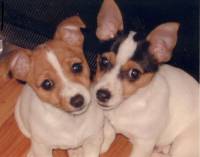An 'Eye for a Dog'
 Tenterfield Terrier puppies
Tenterfield Terrier puppies
This article explains an 'eye for a dog' or the ability to instantly recognize and appreciate the dog's unique features as described within its Breed Standard. Whether you are a breeder, a judge, an interested owner or a dog enthusiast it is most important to develop what we call in dog jargon, an 'eye for a dog'. Then you can truly appreciate a dog that contains all the essentials contained within its Breed Standard but and at the same time, is of top quality. But how do you recognize top quality in a dog?
Quality
 Shih Tzu
Shih Tzu
While one would expect a top quality dog to be the one that wins dog shows, this is not necessarily the case. A top quality dog must also have a natural temperament that commands attention like an aristocrat of its breed. In a show ring situation, correct coat preparation and handling also come into play. A dog may conform to its Breed Standard point by point, but without these additional intangible factors, one would have to look very closely to assess its conformation. On the other hand, a dog can be eye catching and exhibited with great flair and showmanship, yet not fulfill all the requirements of the Breed Standard.
A person with an 'eye for a dog' can immediately see and understand the correct mix of the physical and intangible of a top quality dog. The following is a quote I personally like which describes this mix in an Arab Horse:
It (quality) is an intangible something which does not depend solely on line, but a combination of line, thickness, thinness, width, depth, curve etc., their relation to each other producing a certain perfection and exquisiteness of harmony without which dull correctness is lifeless and uninteresting. A pride of carriage, a ripple of movement, suppleness and grace of modelling which other animals equally good in points have not got.[1]
 Saint Bernard
Saint Bernard
For dog judges and breeders,'dull correctness' can apply to an interpretation of the Breed Standard. This includes correctly assessing many characteristics like basic structure, movement, coat, colour and size of the dog. To preserve our pure breeds, it is fundamental to respect and adhere to the current Breed Standard. But a top quality dog includes the intangibles as well.
If you are attempting to learn about a particular breed, ask exhibitors and breed enthusiasts questions. Most are happy to discuss characteristics affecting their breed. Additionally, spend time studying dogs in all media - books, magazines, video and DVD - observing dogs ringside as well as actually comparing dogs within particular breeds. Then, the eye will become accustomed to recognizing correct breed type. When you are able to combine this with the elusive intangibles, you will have developed 'an eye for a dog'.
References and Further Reading
[1] Lady Wentworth "The Swift Runner" (about Arabian Horses) London: 1957 George Allen & Unwin
Note: This article which coins the phrase an 'Eye for a Dog' is a re-vamp of several articles by Jane Harvey in her 'Judging Terriers' series in 'the National Dog Newspaper' during the late 1970's. The term an 'Eye for a dog' had then been around for decades and has always been synonymous with recognizing correct Breed Type. In 2017 the Kennel Club (UK) and the Finnish Kennel Club announced they were creating an 'Advanced Judging Course' also entitled an 'Eye for a Dog'. This article is not directly connected with this proposed Course.